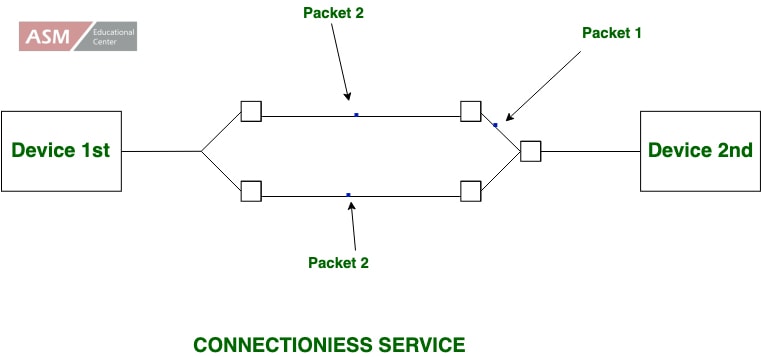Distinguish between Connection-Oriented and Connectionless Service

Connection-Oriented Services
In a connection-oriented service, each packet is related to a source/destination connection. These packets are routed along a similar path, known as a virtual circuit. Thus, it provides an end-to-end connection to the client for reliable data transfer.
It delivers information in order without duplication or missing information. It does not congest the communication channel and the buffer of the receiving device. The host machine requests a connection to interact and closes the connection after the transmission of the data.
Mobile communication is an example of a connection-oriented service.

Connectionless-Service
In connectionless service, a router treats each packet individually. The packets are routed through different paths through the network according to the decisions made by routers. The network or communication channel does not guarantee data delivery from the host machine to the destination machine in connectionless service.
The data to be transmitted is broken into packets. These independent packets are called datagrams in analogy with telegrams.
The packets contain the address of the destination machine. Connectionless service is equivalent to the postal system. In the postal system, a letter is put in an envelope that contains the address of the destination. It is then placed in a letterbox.
The letter finally delivers to the destination through the postal network. However, it does not guarantee to appear in the addressee’s letterbox.

Differences
The major differences between connection oriented services and connectionless services in computer network are as follows−
Connection Oriented Services
It can generate an end to end connection between the senders to the receiver before sending the data over the same or multiple networks.
It generates a virtual path between the sender and the receiver.
It needed a higher bandwidth to transmit the data packets.
There is no congestion as it supports an end-to-end connection between sender and receiver during data transmission.
It is a more dependable connection service because it assures data packets transfer from one end to the other end with a connection.
Connectionless Services−
It can transfer the data packets between senders to the receiver without creating any connection.
It does not make any virtual connection or path between the sender and the receiver.
It requires low bandwidth to share the data packets.
There can be congestion due to not providing an end-to-end connection between the source and receiver to transmit data packets.
It is not a dependent connection service because it does not ensure the share of data packets from one end to another for supporting a connection.







